February 02, 2008
Another option I've been playing with is denim, which is also a very fine slow abrasive, but because it's a finer weave than linen it doesn't seem to knock the edge off kilter as much. I've had great success stropping on the denim and going directly to the shave. Unfortunately denim is much flimsier than the linen used for strops, so I put it on a paddle strop.

Posted by: mparker762 at
09:18 PM
Post contains 218 words, total size 1 kb.
December 02, 2007
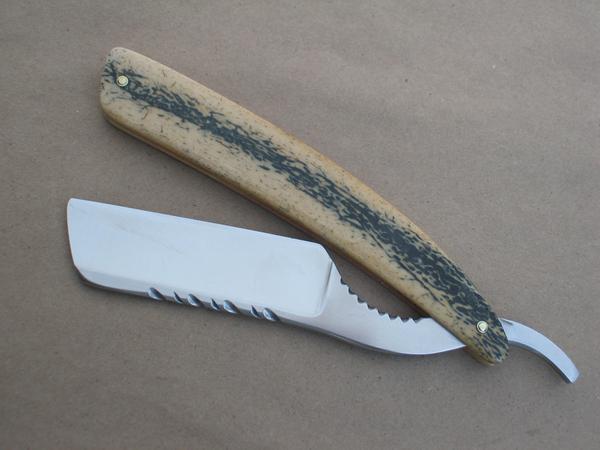
This was Bill Ellis's first razor. Stainless steel, hardened to about 65RC. The scales are made from oosik, which is the penile bone from a walrus. Filework on the spine and shank, and a french point.
Here's a close-up of the spine.
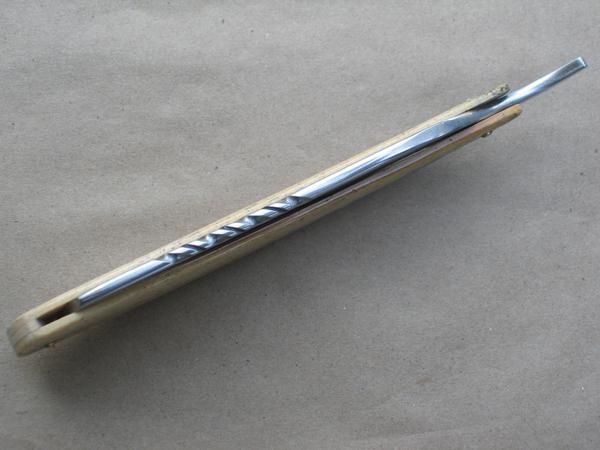
And yes, it shaves as well as it looks.
Posted by: mparker762 at
04:06 PM
Post contains 81 words, total size 1 kb.
November 11, 2007
Every now and then these show up on ebay. Puma scales and the Puma name on the shank...
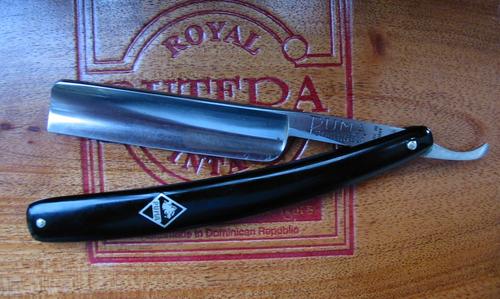
And the Bresnick name and ducks on the back.
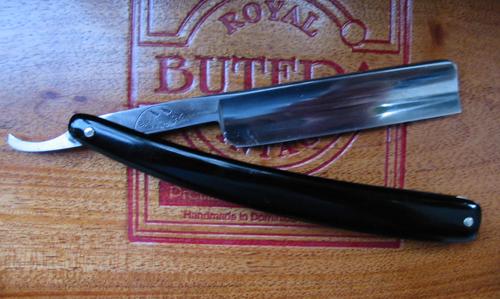
These oddball razors are one reason that straight razor fans suspect that Puma was the OEM for the Dubl Duck razors. The question is how they came to have the stampings for both companies... One theory is that the entry of the US into WWI left Puma with a bunch of Dubl Duck blades that they finished as Pumas. Dubl Duck razors tend to have slightly longer blades than standard, and all of these puma-ducks have very close-fitting scales - on mine the blade barely clears the end wedge, and on some of them the tip of the blade actually clips the wedge.
Posted by: mparker762 at
11:28 PM
Post contains 132 words, total size 1 kb.
October 28, 2007
- C-Mon "Cadillac" razor ($59.95 from Appleton's Barber Supply)
- Illinois #127 strop ($28.95 from Appleton's Barber Supply)
- Strop honing paste ($6.99 from Classic Shaving)
- Hess shaving brush, in pure badger ($25.95 from Appleton's Barber Supply)
- Gold-Dachs Rivivage/Spezial shaving soap ($8.99 from Classic Shaving)
- Styptic - just in case ($2.99 from Classic Shaving)
- coffee cup of your own - free.
Which works out to $133.82 if I did the math right. The only consumables in the list are the soap and styptic, and hopefully you won't need the styptic very often (I use it maybe once a month). The soap should last at least 6 months to a year with normal use. You can do this cheaper if you pick up an inexpensive vintage razor from ebay, but the odds of getting one in easily-serviceable shape are not good unless you have a fair amount of experience with razors. I still get bitten on occasion.
For a nice upgrade from the inexpensive C-Mon the Dovo Ebony Stainless ($99) or Dovo Buffalo Horn Stainless ($160) are good choices if you live near the sea or in a humid climate. And I personally feel the Dovo Bergischer Lowe ($160) is one of the best razors ever made - modern or vintage; just make sure to cut off the stupid rubber piece on the shank since it gets loose and moves around and traps moisture underneath - and the Bergischer Lowe is not a stainless steel razor.
To get all this stuff ready for shaving takes a little bit of initial prep work.
- Avoiding a mess: Put the Dovo honing paste into the refrigerator. It will melt into a puddle if it gets too warm.
- Preparing the soap: Put the soap in your coffee mug, flat side down. If it's too large to fit then trim it to a smaller diameter with a knife, and toss the scraps in the mug on top of the puck (they'll melt back together with a few days of use).
- Conditioning the strop: Hold your brush under hot tapwater until the bristles are soaked (10-15 secs). Shake it out until the bristles are just damp, then run it around on top of the soap in the mug until a thick cream forms at the tips of the bristles. Brush this onto the smooth leather surface of the strop, and brush it around a bit. This helps clean any tanning and preservative residue off the surface of the leather. Wipe the lather off, then do this again and leave the lather on the strop for a few hours. Rub the soapy residue into the leather, then lather up the strop again and let it sit again, and rub the residue back into the strop again. This helps condition the surface of the leather so the razor will glide smoothly.
- Preparing the honing surfaces: Unscrew the straps from the mount, and put it back together with just the linen piece in the mounts. Rub the red paste into one side, and rub the black paste into the other side. You want a fairly thin coating but it should be reasonably even side-to-side (you don't want just a strip longways down the middle or something like that). Make sure you wash your hands thoroughly between handling the red paste and handling the black paste to avoid cross-contamination. Put the paste blocks back in the refrigerator, and let the paste on the strop dry overnight.
- Mounting the strop: Hang the strop from some solid point like the bathroom doorknob. I tied a shoelace around the bathroom doorknob, and clipped the strop onto this shoelace.
- Honing the razor, part 1: Grasp the handles in your right hand, and pull the strop so it's pretty tight. You don't want to pull it out of the wall or break the clip, but there shouldn't be any sag in the strop. With the coarse red-pasted linen side facing up, lightly run the razor over the strop, holding it flat on the linen and moving it spine-first down the strop. When you get to the end, roll the razor's edge up off the strop and flip it over, then run the razor down the strop the other direction. For best results the edge should start lifting up off the strop while the razor is still moving, and the flip should not complete and the edge touch back down until the razor is moving the other direction. Don't worry if this feels awkward; it's not a natural movement but with repetition it will eventually come naturally and smoothly. Despite what you may have seen in the movies, speed is not important here. Just make sure to use a light touch and execute the flips properly. One trip down the strop and back is one lap, and you should do 50 laps on the red paste before moving on to the next step.
- Honing the razor, part 2: Pull out a strip of toilet paper, and fold it up a few times and lay it on your countertop. Strop the razor on this strip of paper a few times to help remove any red paste that may be stuck to the razor. Use some more toilet paper to wipe off the spine of the razor to remove any paste there. You don't want any of the coarse red paste getting onto the fine-grit black side. Don't use a paper towel - they are too abrasive. And if you use a cloth towel your wife will be mad.
- Honing the razor, part 3: Flip the strop over so the black-pasted linen side is facing up. Strop the razor on this side again for 50 laps the way you did in step 6. Wipe off the paste as in step 7 (use different pieces of toilet paper for each step of this to avoid cross-contamination), and hold the razor above your arm and see if it catches and pops the hair on your arm without touching the skin. If it pops the hair on the upper side of your arms then you're getting close. If it pops the hair on the inside of your arms then you're ready to test the razor, if it doesn't pop the hair on the inside of your arms then you need to go back and do steps 6,7, and 8 again - some razors take a little more work their first time, and may need a few iterations through this honing sequence.
- Return the strop to the normal configuration: Once the razor is sharp, go ahead and close it up and put it away. Unhook your strop and unscrew the mount and put the leather back in so the smooth leather side and the black pasted sides are facing out.
When you get ready to shave in the morning, start out by pulling the strop taut and stropping the razor about 30-40 laps on the leather side. Then flip the strop over, pull it tight again, and give it another 10-15 laps on the black pasted side. As you get better at shaving and stropping you can gradually reduce the number of laps on the black pasted side of the linen until you are doing just enough laps each day to keep the razor sharp. You may even be able to eliminate the daily stropping on the abrasive linen and only use it for a few laps on the weekend - everybody is different and has different requirements. But you should always do at least 30 laps on the leather side every day before shaving - the leather acts like a chef's steel and keeps the thin cutting edge straight and aligned.
Your basic Illinois #127 strop:

One side pasted with Dovo red (coarse abrasive):

Other side pasted with Dovo black (fine abrasive):

Disassembled showing the component parts:
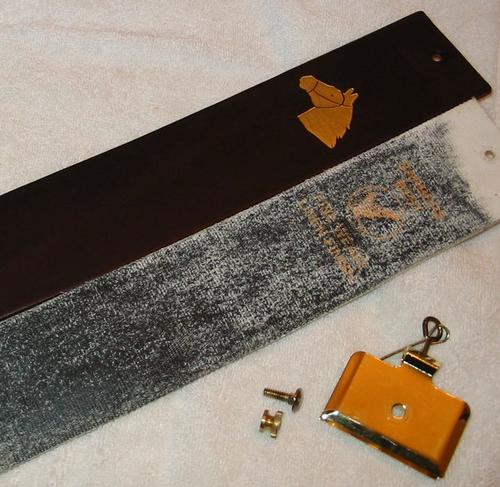
And hanging from the doorknob:
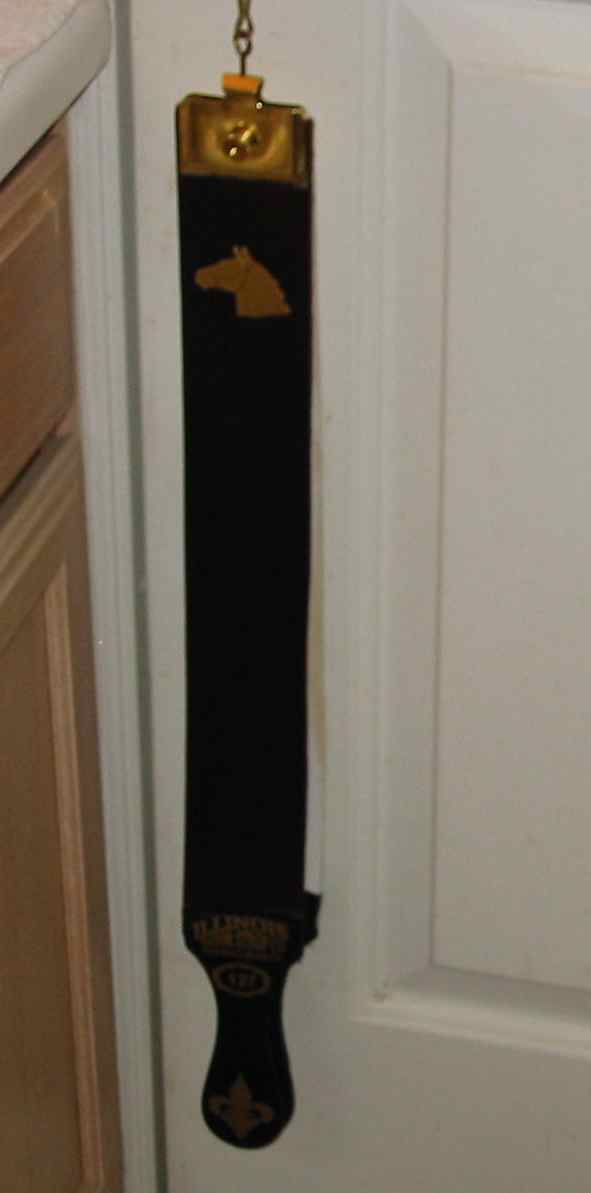
Posted by: mparker762 at
12:48 PM
Post contains 1363 words, total size 9 kb.
October 02, 2007
There are really two basic phases in razor honing. The first phase (and probably the hardest) is simply getting the razor shaving-sharp in the first place. The second phase keeping it that way.
The first problem can be solved by buying the razor from a company like Classic Shaving that offers a professional honing service, or by sending the razor out to a skilled razor honer. Doing it yourself is certainly possible but requires a great deal of practice and some potentially expensive equipment.
If you are trying to use a straight razor for your daily shaver the most important problem is keeping the razor sharp. The first prerequisite is stropping the razor before each shave. Contrary to what you may have been led to believe, stropping does *not* sharpen the razor. It simply cleans the edge of any corrosion that may have developed overnight (and there will have been some, at the microscopic level) and helps straighten it out similar to the way a chef uses a knife steel. Stropping will help extend the life of the edge but eventually the edge will deteriorate and will need honing to recover its shaving ability. How long a razor can go between honings depends on a variety of factors such as the wiriness of your beard, the quality of your stropping technique, and the corrosiveness of the environment (humidity kills razors). Some people also have naturally acidic or salty skin that also tends to reduce the life of the edge.
There are two main flavors of strop in common use in the US: the traditional hanging strop (usually hung from a carriage bolt or the doorknob), and a paddle strop which is basically a board covered in leather with a handle attached. There is a third type called a loom strop that is sometimes found in Europe. This is a paddle-type strop with a stretcher mechanism inside a loop of leather, and it combines the small size of the paddle strop with the stropping "feel" of a hanging strop.
As the razor's edge degrades over a few weeks (or months) of shaving it will eventually start pulling at your whiskers a bit, and if this cannot be cured by additional stropping then it is time to refresh the edge by removing some metal. One of the most easily mastered method of doing this is the abrasive strop. This simply requires the user to repeat his well-practiced stropping motion, and the abrasives embedded in the strop will return the razor to shaving form in only a few laps. Some experienced straight razor shavers prefer to refresh their razor on the same water hones that were used to put on the initial edge. And around the turn of the century most barbers used small specialized ceramic hones that have come to be known as "barber hones"; though these are no longer being made they are readily available on ebay. However, barber hones and water hones are more difficult to master than the abrasive strop, and are best left until a new shaver has gotten a little more experience, if only to avoid unnecessary learning curves early on.
Both paddle strops and hanging strop may be embedded with abrasives and used to sharpen a razor. Paddle strops are probably the most commonly used form of abrasive strop today, but according to my father (who lived with his grandparents for many years during and after WWII), my great-grandfather never used a stone on his razor. He kept it sharp all those years using only his hanging strop which apparently had some sort of abrasive on the linen side. I have both types myself, and find that they both work well, though the abrasive hanging strops seem to be more aggressive.
One place where I think the abrasive hanging strops really have no peer is sharpening the big Sheffield choppers. These razors tend to be huge and heavy and have equally huge bevels, and fine-grit stones are simply too slow to put a really sharp edge on the razor in a reasonable amount of time. But the hanging strops have 15 inches or so of stroke instead of the 6 or 7 inches on a hone or abrasive paddle, so they get the job done much more quickly. Even the biggest Sheffield razor can be refreshed with only a few dozen strokes on an abrasive hanging strop.
My favorite abrasives on these strops are 1.8 micron boron carbide and 0.5 micron chromium oxide. I also have a hanging strop with one side treated with Flexcut Gold, whis is a coarse fast-cutting abrasive that is used for rough work on the big Sheffields as well as sharpening our chef's knives and my pocketknives.
Photos below...
more...
Posted by: mparker762 at
12:25 PM
Post contains 1269 words, total size 9 kb.
September 13, 2007
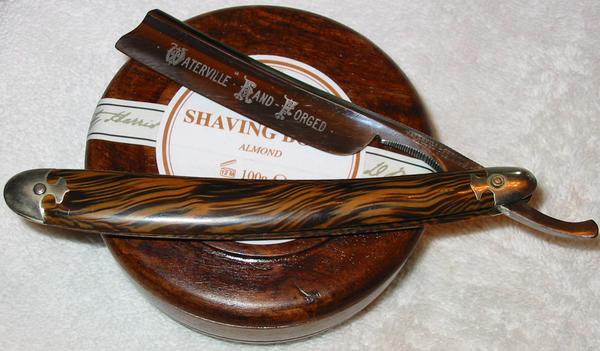
This was my first Waterville razor, and I believe it to be the oldest of the bunch as well. This razor is unusual in that it has "Made in England" etched into the back side of the tang - this is the only such Waterville that I and several straight razor experts have ever seen. Because this razor has some similarities with the older style of Watervilles it is quite possible that Waterville started out importing razors from Sheffield before they ramped up their own production facilities. The scales are not original - when I acquired it it was wearing some cheesy bamboo-looking faux-ivory scales, though those were also not original as the pins were 20th century Solingen-style nail-pins. Also it appears that a previous owner had chipped the tip of the razor and "repaired" the damage by grinding out the chip into a vee-notch.
It holds a special place for me as this was the razor that convinced me to switch from the big Sheffield wedges to the smaller lighter 5/8 size full hollows. Unfortunately that vee-notch in the tip kept gouging my strops, so if I was going to continue to use it I would need to do something about the tip. I put this razor away for many months while I pondered my options. Eventually I decided to go ahead and modify the tip of the razor. I reground it into the modified oblique shape shown above, which meshes well with the existing lines of the razor and immeasurably improves the razors behavior on the strop.
Posted by: mparker762 at
03:39 PM
Post contains 336 words, total size 2 kb.
August 14, 2007
Frustrated, I picked up one of the new Fusion razors and got an absolutely great shave right off the bat. The second day's shave was pure hell - the five blades had apparently taken off a lot of skin along with the hair and on the second day there wasn't enough skin left and the blades were scraping too close to the nerves. Shaving every other day wasn't an option.
At this point I was getting desperate. The last really great shaves I had ever had were with the old Trac-II back before Gillette nerfed the blades. My best shaves were old-school, so I decided to try going even older-school. I noticed that the double-edge razor blades were still available, and some quick Google-fu revealed that the Personna blades made by American Safety Razor were pretty good, and that some web stores were bringing in very blades from Germany and Japan. This looked promising, so I bought a DE razor ($15 on ebay) and a pack of Personna blades ($1.50 for a 10-pack at Wal-Mart). Since I was tiptoeing into the old-school pool I also got a shaving brush ($10) and a puck of Williams Shaving Soap ($1) from the grocery store.
The first day's shave was pretty good. Not as good as the old Trac-II, but definitely one of my best shaves in years. My experience with the Vision made me skeptical - you can get away with anything once - but the second day's shave was also pretty good. And the 90th shave three months later was also pretty good. The exceptions was the goatee region around my mouth and the lower neck area, both of which were still tough going. The DE wasn't leaving these areas raw and blistered like the electric and M3, but it wasn't shaving them very close either. The problem in these areas are tough whiskers that grow very flat so that the razor can't get them close when shaving with the grain, but which tend to snag and catch when shaving against the grain.
As an aside, I think it is a real shame that canned foams and gels have superceded the shaving brush and shaving soap. Very few of the canned lathers seem to soften your beard at all; you can get a closer shave using only hot water, and it's just as comfortable. Using a shaving brush and soap does a couple of things. First it cleans the oils and dirt off your face (shaving soap is still soap after all). Secondly it softens the beard by saturating it with water, and the lather keeps the water from evaporating too fast. And finally the swirling motion with the brush helps get the whiskers to stand up. It is cheap too - a puck of traditional hard shaving soap will last between 6 and 12 months. With this sort of life expectancy, inexpensive soaps like Williams ($1/puck) are an incredible deal and even fancy English soaps from venerable firms like Truefitt and Hill ($12/puck) are still much cheaper than grocery-store creams or gels. And the soaps (at least the English ones) smell much better than the canned stuff. Even for guys using the newfangled cartridge razors a brush and soap should be a major step up in shaving closeness and comfort. But I digress...
In searching around on the net for a solution to my goatee area I was surprised at the number of recommendations for the straight razor. The claim was that the heavier blade did a better job cutting stiff whiskers, and because there was no safety guard the blade could be dropped very flat to slide underneath the tips of the whiskers and get a clean cut without digging in. I was skeptical - skeptical that I could use one safely, and skeptical that a straight would do as well as its fans were claiming. But I had already taken a large step back in time with the DE razor; trying a straight was just one step farther.
Posted by: mparker762 at
07:59 PM
Post contains 872 words, total size 5 kb.
July 22, 2007
Posted by: mparker762 at
12:29 PM
Post contains 127 words, total size 1 kb.
July 21, 2007
more...
Posted by: mparker762 at
12:48 AM
Post contains 205 words, total size 1 kb.
39 queries taking 0.0299 seconds, 93 records returned.
Powered by Minx 1.1.6c-pink.









